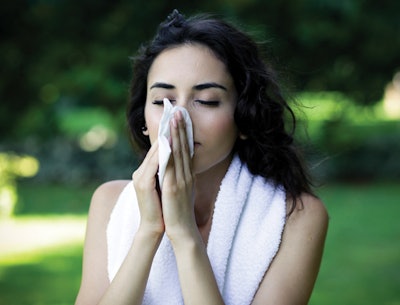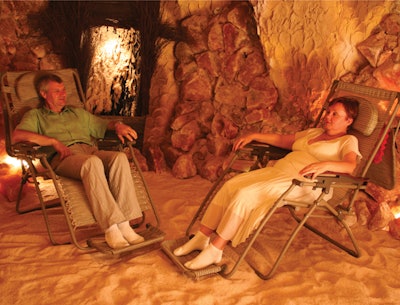 © istockphoto.com
© istockphoto.com© istockphoto.com
What can a day spa do to quell the symptoms of nasal and respiratory allergies?
Is it your imagination, or do the congestion, coughing and other symptoms that go along with nasal and respiratory allergies seem to be affecting more people every year—and for longer periods? With so many allergy sufferers appearing symptomatic from January through December, you might wonder whether the term “seasonal allergies” has become obsolete.
An estimated 50 million Americans suffer from some type of allergy, according to the Asthma and Allergy Foundation of America. Some exhibit allergic reactions to ingested foods or drugs, and some to skin contact with substances such as latex or certain plants. But the primary allergies in most people are referred to as “indoor/outdoor,” meaning that their immune system reacts to a protein substance, or allergen, in their environment that is breathed in or touched.
And allergens abound. “There are trees in spring, grass in summer, weeds in fall, and year-round dust mites and animal dander,” explains Dr. Nkiruka Erekosima, allergist/immunologist at Johns Hopkins Hospitals and Medical Centers, Baltimore, Maryland. And, according to Erekosima, the increased suffering is not imagined. “With climate changes and global warming, pollens last longer than they used to,” she confirms. “Pollen counts stay high, and patients suffer more and worse symptoms.”
Where do you come in? Although prescription medications, over-the-counter preparations and age-old home remedies—sometimes in regimented combinations—provide relief, your spa services and retail products can still do much to help clients who suffer from this nagging medical problem.
The Ins and Outs
Indoor/outdoor allergy sufferers experience seemingly endless congestion and runny nose, and it doesn’t stop there: They may have sinus pain and inflammation, red and itchy eyes, sore and scratchy throats, ear pain and coughs. Allergies can lead to wheezing and breathing problems including extrinsic asthma, a condition in which the airways become blocked. Asthma, in turn, can cause chest pain, shortness of breath and even fatigue.
While allergies can strike anyone at any time, there is a genetic predisposition. The Asthma and Allergy Foundation reports that if one of a child’s parents has allergies, the chances are one in three that the child will have allergies as well. If both parents have the condition, that chance increases to seven in 10. And although allergies are most likely to develop in childhood, the symptoms may not present until later in life, or during times when exposure to the allergens is higher.
Geographical location can also contribute to nasal and respiratory allergies. “Allergens are often present in areas with high humidity,” says Erekosima. “For example, dust mites grow when there is more water content in the air. They don’t grow in dry climates.”
Although there is no “cure” for allergies, they can go into remission—unfortunately, they can also return with no warning.

@ istockphoto.com
Snuffing Out Symptoms
Allergies are diagnosed through testing in which the practitioner exposes the patient to the allergen and then examines the reaction. Conventional medicine offers a spectrum of medication for treating allergies, such as over-the-counter antihistamines and prescription nasal steroid sprays to reduce inflammation in the mucus membranes. Often the condition is treated with “allergy shots” through which the allergen itself is administered with the goal of eventually desensitizing the patient to it. Erekosima believes that sublingual (under the tongue) preparations—which are available but not yet FDA-approved—will ultimately replace the injection method.
If treating the allergy with the substance that causes it sounds familiar to alternative wellness professionals, that’s because it is a classic example of homeopathy, the hundreds-year-old discipline still commonly practiced in Europe. The founding principle of homeopathy is that “like cures like,” a strategy widely embraced in treating allergies.
“When allergens such as pollen are distilled down and potentized, they will actually relieve the symptoms,” explains Dr. Richard Hiltner, a family practitioner and doctor of homeopathy who practices in Ojai, California—a valley rich in vegetation and surrounded by mountains and, therefore, a breeding ground for outdoor allergies. The homeopathic remedies that he prescribes come in many forms, including sublingual pellets, liquid drops, sprays, eye drops and more.
Acupuncture can also be a powerful treatment for alleviating allergy symptoms. “Through acupuncture we can work on the lung channel,” Hiltner explains. “Also, there are channels around the nasal area that correspond to the stomach and digestive systems, which can relate to allergies. We look at the whole and holistic picture of the individual—mental, physical, emotional, it’s all related.”
Stress and negative emotions may also play a role in exacerbating symptoms, as they can weaken the adrenal glands, says Hiltner. Therefore, treatments and supplements that support the adrenal system can have a positive effect on the lungs and, as a result, respiratory allergies.
Hiltner also stresses the importance of an anti-allergy diet. “It has long been known that dairy [and other foods] can adversely affect sinus problems,” he points out. “If someone is suffering from allergies and they’re drinking milkshakes and eating processed foods, of course that will have an effect.” He also cites alcohol, caffeine and exposure to toxins as added stressors on the proverbial camel’s back, working cumulatively to cause it to break. Ultimately, Hiltner says, chronic allergies are a constitutional weakness.

Williamsburg Salt Spa’s salt therapy area helps guests breathe easier.
Spa-Style Relief
Even if your spa doesn’t offer acupuncture or homeopathy, you may still be able to help your allergy-prone clients with gentle yet effective treatments. For example, basic aromatherapy can be beneficial, alone or combined with another treatment. Eucalyptus is helpful to the lungs, says Hiltner, and lavender, cedar and tea tree oil may soothe nasal passages. Lymphatic drainage therapies may help as well. “The lymphatic system carries large proteins,” Hiltner says. “It’s the sanitation system through the lymph nodes and mucus membranes,” says Hiltner. In fact, any kind of manipulative work to the face may help with congestion.
A unique and time-honored approach to calming allergy-related distress is salt therapy (also called halotherapy or speleotherapy), which hails from Poland. Clients sit in a specially built salt “mine” and inhale the microclimate, which is rich in minerals such as sodium, potassium, calcium, magnesium, iron, bromine and iodine.
“Salt therapy brings allergy relief by opening the airways of the respiratory tract,” says Agnieszka Adamska, co-owner of the Williamsburg Salt Spa in Williamsburg, Virginia. “The micro-particles of salt kill bacteria and reduce inflammation. The salt dries out the mucus so you can breathe much easier.” While guests often notice a difference after only one session, Adamska recommends a series of visits. “By coming in on a regular basis they will improve their immune system,” she says, and reports that many of the spa’s clients have been able to shelve some medications after embracing salt therapy.
Adamska retails a salt air inhaler at her spa for take-home use, which clients can use whenever their allergies act up. She also recommends use of a neti pot, a popular nasal irrigation device, for a warm water and salt rinse twice a day. It should be noted, however, that neti pots have garnered health warnings of late; there have been reports of bacteria from water in the pot leading to death in several users. As with any foreign article entering the body, proper usage and sterilization is essential. “Nasal saline can help some people with milder symptoms,” Erekosima acknowledges, “but make sure to clean the equipment completely, follow all of the manufacturer’s instructions and replace as suggested.”
As with any medical issue, if clients come to you seeking help for allergy symptoms, be sure a physician has diagnosed them first. Symptoms of flu and other viruses can be easily confused with those of allergy. “The typical differentiation is that with flu there may be fever, muscle pain and infection. The nasal drainage might not be a clear liquid,” says Erekosima. “Also, if the symptoms go away after a couple of weeks then it was probably not allergies.”
On-the-Nose Advice
Help clients with allergies avoid flare-ups by sharing these recommendations from the Asthma and Allergy Foundation:
• Do outdoor activities before 10:00 a.m. or after 4:00 p.m., when pollen counts in the air tend to be lower.
• Stay indoors when humidity or wind is high.
• When indoors, further reduce exposure to outside pollens by keeping windows closed and using an air filter.
• Dust, clean all bedding, and vacuum frequently to control dust mites and pet dander.
• Shower after exposure to allergens to reduce traces left on skin and hair.
Andrea Renskoff is a freelance writer based in Los Angeles.
Build your spa business with spa marketing and spa management tips • Read about professional spa products • Enter for a chance to win spa skincare, face & facial products, skin cleansers and more • Subscribe to DAYSPA • Subscribe to DAYSPA‘s eNewsletter











